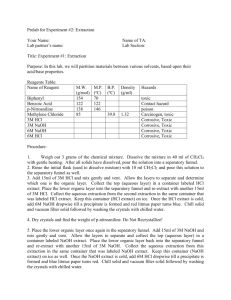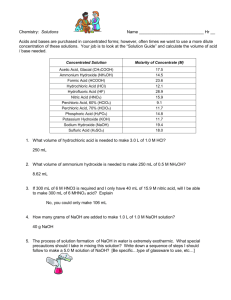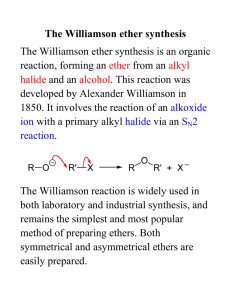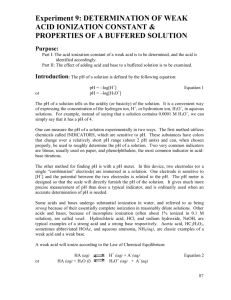Procedures
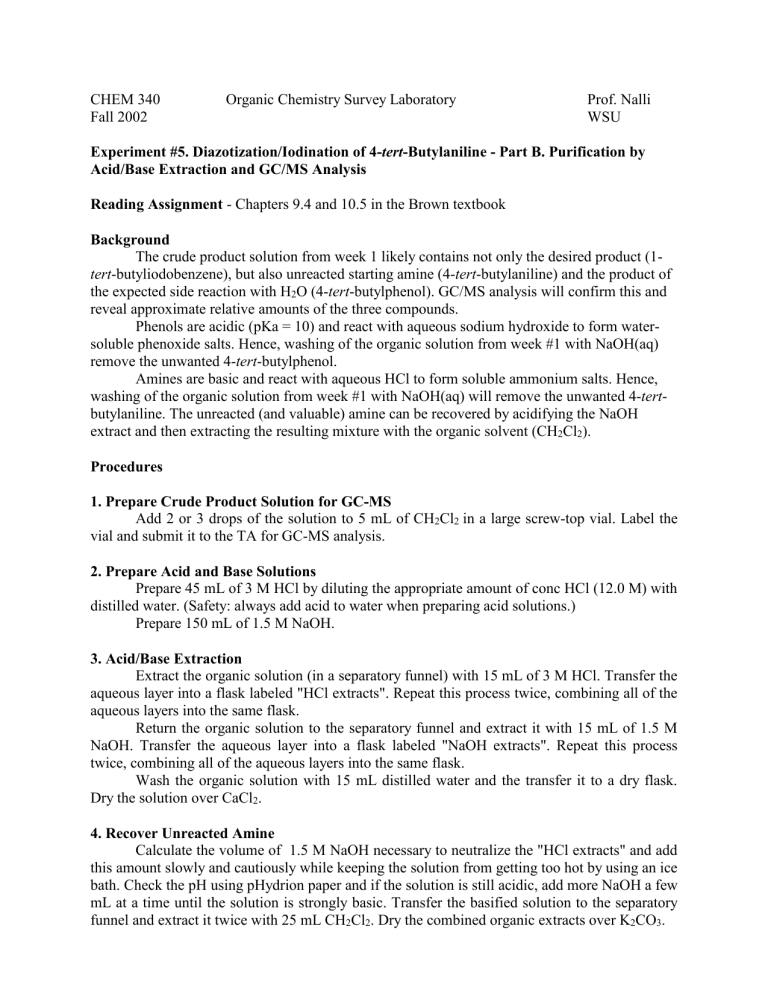
CHEM 340
Fall 2002
Organic Chemistry Survey Laboratory Prof. Nalli
WSU
Experiment #5. Diazotization/Iodination of 4-tert-Butylaniline - Part B. Purification by
Acid/Base Extraction and GC/MS Analysis
Reading Assignment - Chapters 9.4 and 10.5 in the Brown textbook
Background
The crude product solution from week 1 likely contains not only the desired product (1tert -butyliodobenzene), but also unreacted starting amine (4tert -butylaniline) and the product of the expected side reaction with H
2
O (4tert -butylphenol). GC/MS analysis will confirm this and reveal approximate relative amounts of the three compounds.
Phenols are acidic (pKa = 10) and react with aqueous sodium hydroxide to form watersoluble phenoxide salts. Hence, washing of the organic solution from week #1 with NaOH(aq) remove the unwanted 4tert -butylphenol.
Amines are basic and react with aqueous HCl to form soluble ammonium salts. Hence, washing of the organic solution from week #1 with NaOH(aq) will remove the unwanted 4tert butylaniline. The unreacted (and valuable) amine can be recovered by acidifying the NaOH extract and then extracting the resulting mixture with the organic solvent (CH
2
Cl
2
).
Procedures
1. Prepare Crude Product Solution for GC-MS
Add 2 or 3 drops of the solution to 5 mL of CH
2
Cl
2 in a large screw-top vial. Label the vial and submit it to the TA for GC-MS analysis.
2. Prepare Acid and Base Solutions
Prepare 45 mL of 3 M HCl by diluting the appropriate amount of conc HCl (12.0 M) with distilled water. (Safety: always add acid to water when preparing acid solutions.)
Prepare 150 mL of 1.5 M NaOH.
3. Acid/Base Extraction
Extract the organic solution (in a separatory funnel) with 15 mL of 3 M HCl. Transfer the aqueous layer into a flask labeled "HCl extracts". Repeat this process twice, combining all of the aqueous layers into the same flask.
Return the organic solution to the separatory funnel and extract it with 15 mL of 1.5 M
NaOH. Transfer the aqueous layer into a flask labeled "NaOH extracts". Repeat this process twice, combining all of the aqueous layers into the same flask.
Wash the organic solution with 15 mL distilled water and the transfer it to a dry flask.
Dry the solution over CaCl
2
.
4. Recover Unreacted Amine
Calculate the volume of 1.5 M NaOH necessary to neutralize the "HCl extracts" and add this amount slowly and cautiously while keeping the solution from getting too hot by using an ice bath. Check the pH using pHydrion paper and if the solution is still acidic, add more NaOH a few mL at a time until the solution is strongly basic. Transfer the basified solution to the separatory funnel and extract it twice with 25 mL CH
2
Cl
2
. Dry the combined organic extracts over K
2
CO
3
.
5. Isolate and Analyze the Product
Prepare a sample for GC-MS in the same way as in #1 above.
Carefully decant the solution from the CaCl
2 pellets into a dry, weighed round-bottom flask. Use the rotary evaporator to distill off the solvent. The instructor will assist in the operation of the rotary evaporator.
Weigh the flask containing the final product and then transfer it using a Pasteur pipet into a screw top vial. Label the vial completely and submit it for grading.


